Chiura Obata Tribute Mural & Historical Marker
Introduction
Author-Uploaded Audio
Listen to a narration of this entry's description by Jenevieve Hughes.
Text-to-speech Audio
Images
Chiura Obata Historical Marker
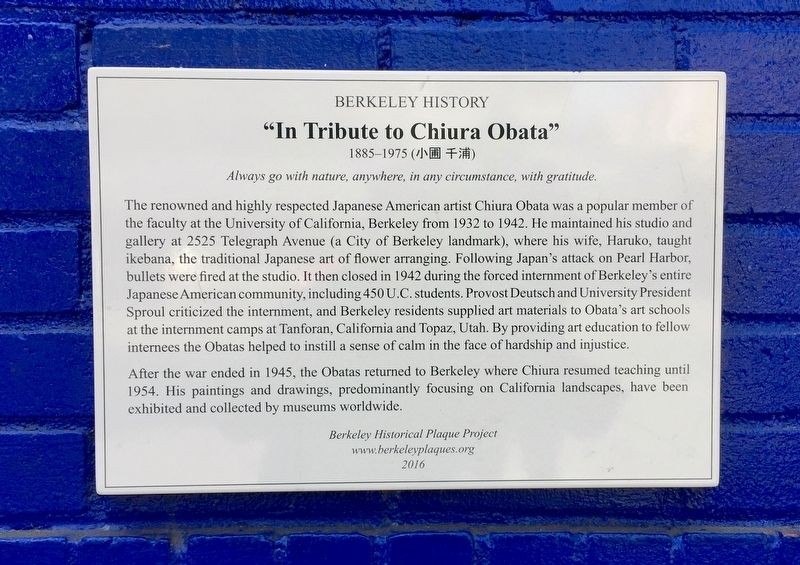
Mural on the side of the building at 2525 Telegraph Avenue, which once housed Chiura Obata's studio and gallery
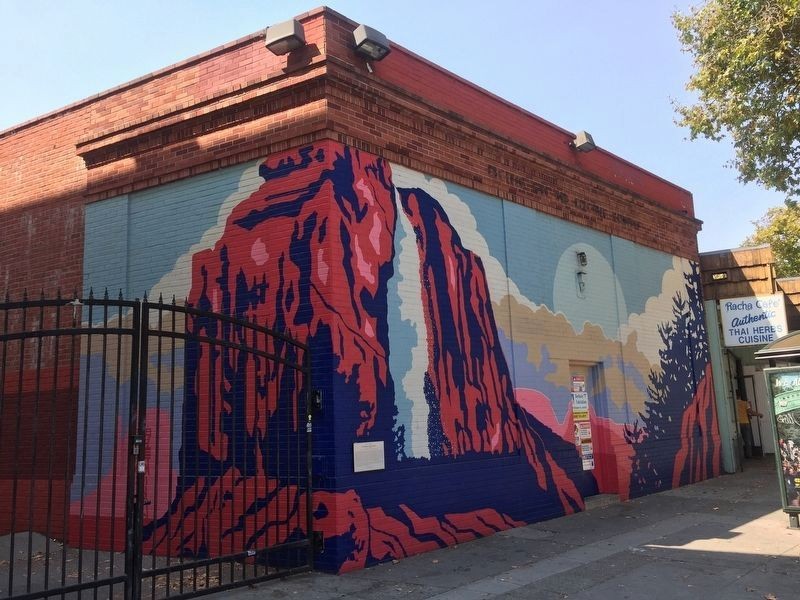
Chiura Obata (1949)
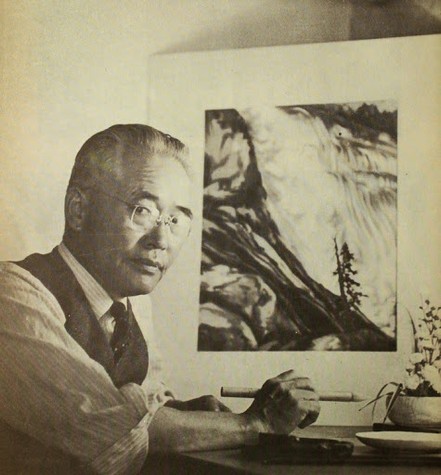
Chiura Obata
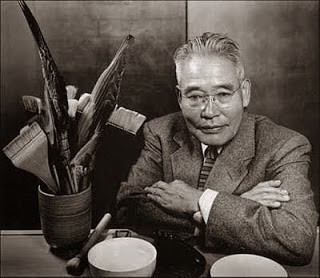
Obata teaching at UC Berkeley (c. 1930s)
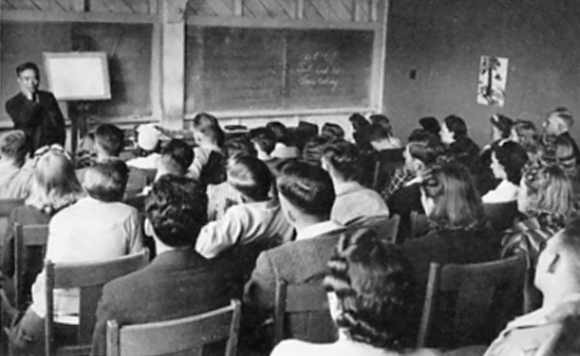
"Evening Glow at Yosemite Falls" (1930), by Chiura Obata
.jpg)
Announcement for the opening of the Obata Studio
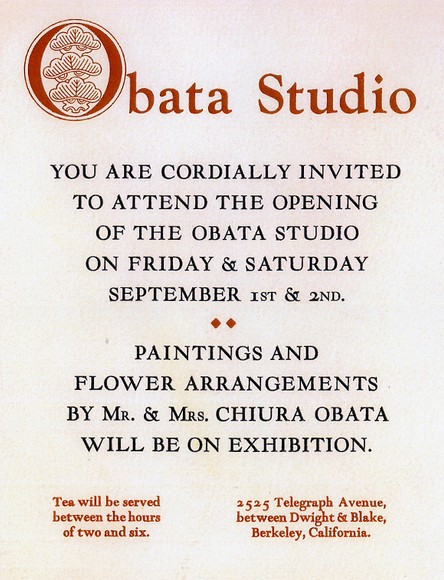
Obata Studio, c. 1930, part of a commercial building complex then called The Arcade
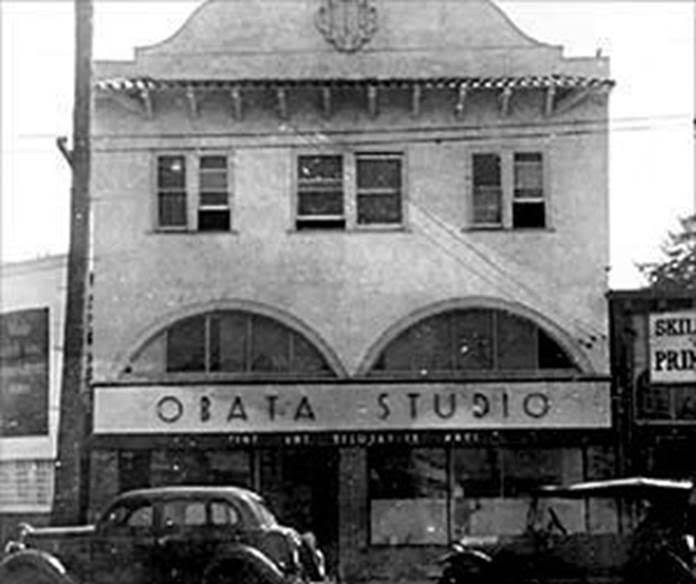
Needham-Obata Building (2009)
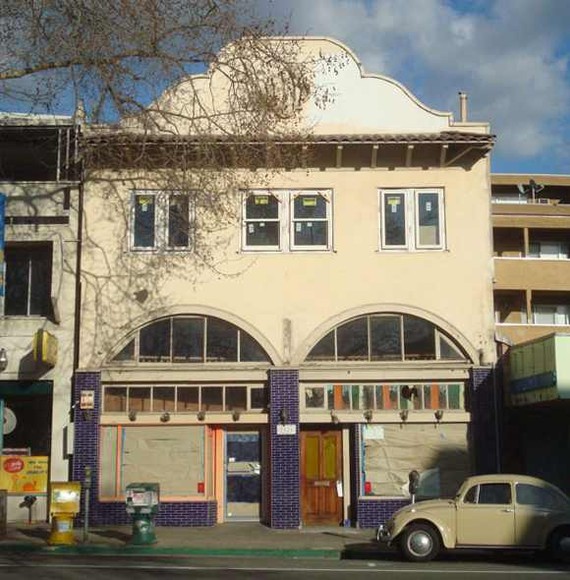
Backstory and Context
Text-to-speech Audio
Chiura Obata (1885 - 1975) was an esteemed professor at the University of California at Berkeley, where he was popular among his students. In addition, he maintained the Obata Studio and Art Goods Store from 1939-1941 in a building that was known as The Arcade. This 1907 commercial building also included a grocer, a barber shop, and a bathhouse, in what was then a Japanese American neighborhood in Berkeley. The building was designated as a City of Berkeley Landmark in 2009, and it features a colorful exterior mural that is titled, "In tribute to Chiura Obata," which was painted by Rich Black in conjunction with Obata's granddaughter, Kimi Kodani Hill.
During his lifetime, Obata primarily painted the California landscape in the nihonga style. This style blended traditional Japanese sumi-e brush painting with modernist watercolor techniques and Western methods of perspective. In the 1920s, Obata founded the East West Art Society, which focused on cross-cultural understanding. One of Obata's best-known works was "Evening Glow at Yosemite Falls" (1930), which features a waterfall tumbling over a dramatic cliff towards a lone tree at Yosemite National Park. In addition to his landscape paintings, many of Obata's paintings featured the decorative floral arrangements that were created by his wife, Haruko. From their shared Obata Studio, Haruko created and taught "Ikebana," the Japanese art of flower arranging.
However, with the onset of World War II, everything changed for the Obatas. After the Japanese bombing of Pearl Harbor on December 6, 1941, people vandalized and fired gunshots at the windows of the Obata Studio. Then in early 1942, the federal government ordered the forced internment of all Japanese Americans who were living on the West Coast. With the state of California rounding up Japanese Americans, the president of UC Berkeley who strongly opposed the internment agreed to store several of Chiura's paintings for safe-keeping. The Obatas also sold off 120 additional paintings at a loss just before their departure. With the money from the sale, Chiura established a scholarship fund for whichever student "regardless of race or creed" suffered the most from the war.
After the Obatas were forced to leave their home and studio in Berkeley, they were sent to live in an internment camp for the remainder of the war, where they endured the hardship and injustice in part by teaching art to the other internees. The Obatas are both well-remembered today for sharing their appreciation of artistic expression with many of the other Japanese Americans who were also imprisoned during the war. A total of 120,000 Japanese Americans were interned, most of which were U.S. citizens. 450 Japanese American students from UC Berkeley were among those interned. Throughout the Obatas' imprisonment, some of his former students sent art supplies to the internment camps located at Tanforan, California, and Topaz, Utah, where the Obatas taught art during the war. The artwork that Chiura created during this period poignantly documents many of the daily realities of their internment, beginning with the moment that a soldier first ushered the Obatas and other Japanese Americans onto a bus for their departure.
When the Obatas were finally allowed to return to Berkeley at the conclusion of the war in 1945, Chiura resumed his position at the university and he continued to teach there until his retirement in 1954. However, Chiura and his wife were unable to return to the same studio space that they shared on Telegraph Avenue. Nevertheless, he continued to paint for the rest of his life and produced many new works during this period. In 1954, Chiura finally became a naturalized U.S. citizen, a status that had been prohibited for Japanese citizens prior to this date.
Like his earlier paintings, many of the artistic works that Chiura Obata produced during this prolific post-war period have since been displayed in galleries, museums, and special exhibitions around the world. In his later years, following his retirement from UC Berkeley, Obata led tours of the U.S. and Japan in order to foster cross-cultural relations. In 1965, Obata was awarded the Emperor's Medal in Japan for promoting understanding between the East and West throughout his life. Obata was known to have expressed words of thanks to his supporters, as well as appreciation for the natural world, which was a source of great inspiration for him. He stated:
“I dedicate my paintings, first, to the grand nature of California, which, over the long years, in sad as well as in delightful times, has always given me great lessons, comfort, and nourishment. Second, to the people who share the same thoughts, as though drawing water from one river under one tree.”
Obata also shared with his art students the following wisdom:
Always go with nature, anywhere, in any circumstance, with gratitude.
Sources
"Chiura Obata Mural", Berkeley Historical Plaque Project. Accessed March 2nd 2020. https://berkeleyplaques.org/plaque/obata-mural/.
"City of Berkeley Landmark Application", City of Berkeley. Accessed March 2nd 2020. https://www.cityofberkeley.info/uploadedFiles/Planning_and_Development/Level_3_-_LPC/LPC_06-02-09_2525%20Telegraph_ATT%201%20Landmark%20Application.pdf.
Graves, Donna. "Berkeley e-Plaque: Chiura Obata, Artist", Berkeley Historical Plaque Project. January 1st 2012. Accessed March 2nd 2020. http://berkeleyplaques.org/e-plaque/chiura-obata/.
Haas, Sophie. "Beginner's Guide to Berkeley Street Art", Daily Cal. October 15th 2017. Accessed March 2nd 2020. https://www.dailycal.org/2017/10/15/beginners-guide-berkeley-street-art/.
Hill, Kimi Kodani. Topaz Moon: Chiura Obata's Art of the Internment. Heyday Press, 2000.
"Needham-Obata Building", Berkeley Heritage. Accessed March 2nd 2020. http://berkeleyheritage.com/berkeley_landmarks/2009_landmarks.html.
Ruppenstein, Andrew. "In Tribute to Chiura Obata", The Historical Marker Database. September 2nd 2018. Accessed March 2nd 2020. https://www.hmdb.org/m.asp?m=122842.
Wood, Cirrus. "Artist Interned: A Berkeley Legend Found Beauty in “Enormous Bleakness” of War Camp", Cal Alumni Association. Accessed March 2nd 2020. https://alumni.berkeley.edu/california-magazine/just-in/2017-04-25/artist-interned-berkeley-legend-found-beauty-enormous.
By Andrew Ruppenstein, The Historical Marker Database
By Andrew Ruppenstein, The Historical Marker Database
Japanese American National Museum
Topaz-diaries.blogspot.com
Obata Family.
Obata Family
Obata Family and the Berkeley Architectural Heritage Association
Obata Family and the Berkeley Architectural Heritage Association
Donna Graves, Berkeley Historical Plaque Project
